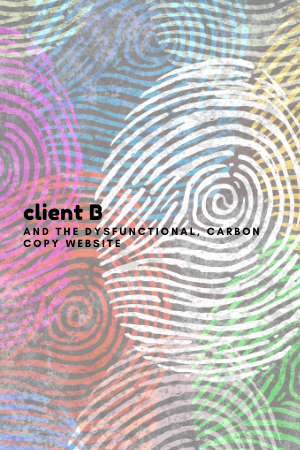This story is the second of a three-part continuation of my previous post on The Importance of Trust, in which I shared several insights about what to look for in a marketing relationship and how to avoid getting scammed. If you missed part 1 (Client A and the Exorbitantly Priced Parked Domain), you may want to read that first (click here).
Unassuming Client B Really Got Screwed
Client B had a decent website and was looking for complementary services to boost his traffic. His site looked fine, worked fine, and didn’t really need any work (at least not yet). The company who was responsible for making it look the way it did when I met him was actually the second company to have worked on it. He had already been burned by another person who’d initially created the site. (Track with me and fast forward to the future — now I’m righting the wrongs of two “professionals” who came before me and working doubly hard to get this guy to trust me.) Yes, he has now paid twice for something that is still not functioning as it should be.
Everything was fine for a couple of years. I managed Client B’s online outreach and promoted his pre-existing website. Then he informed me that he wanted to make some changes to his site, but that he no longer had a relationship with the company who had worked on it (yes, the second company). Like many business owners, the technical stuff can lie just outside their wheelhouse — sometimes not even in the same vicinity — and he thought maybe I could help him.
Business as Usual?
I told him I’d try, and he gave me access. On first glance, I didn’t notice anything unusual. Familiar with the architecture, I was able to make a couple of simple changes. I didn’t charge him, he was happy. Then the spam started. Client B started to get copious amounts of spam emails and form entries through his site, almost as if it had been compromised somehow. I set up a reCAPTCHA and updated his security plug-ins. It worked for a couple of months, but ultimately it turned out to be like putting a band-aid on a broken bone.
And Then He Told Me Something
Upon trying to make additional updates to his site a couple months later, I detected that the site was becoming antiquated. It was failing to update. Some updates are automatic, some are manual, some are at the site-level, some are at the host/server level, and none were working. I pulled out all the stops — I did backups, I created restore points, I used multiple browsers, I used safe mode, I troubleshooted with tutorials things that had never presented difficulties before. And then he told me something.
Client B shared with me that the person who created his site was found guilty of scamming dozens of business owners by building them websites that were, essentially, carbon copies of each other. So Jim’s Pizza in Delaware and Joe’s Pierogies in New York had nearly identical websites as Linda’s Cakes in North Carolina and John’s Painting in Florida. Not only did these sites very closely resemble one another in look and feel and user experience, but their very architecture and all the underlying technical components were copies of each other as well.
I can’t tell you why someone with skill would do this. To save time and maximize profit, perhaps? I also can’t speculate as to whether this was malicious or just a result of a lack of experience (an honest mistake). What I can tell you, is that all of these websites broke, all of them were bad eggs from the start, because there are errors and corruptions proliferating all the intricate pieces that have to properly connect in order for things to be updated and properly functioning. Not only that, but this method of rapid-fire, copy-and-paste site-building is terrible for each site owner’s SEO and organic internet performance!
Now I’m building him a new site from scratch (hopefully to be completed before the existing one completely decays), and hoping that the experience will prove to him that we’re not all bad.
Stay tuned for Part 3: Client C and the Incomplete Work

+ view comments . . .